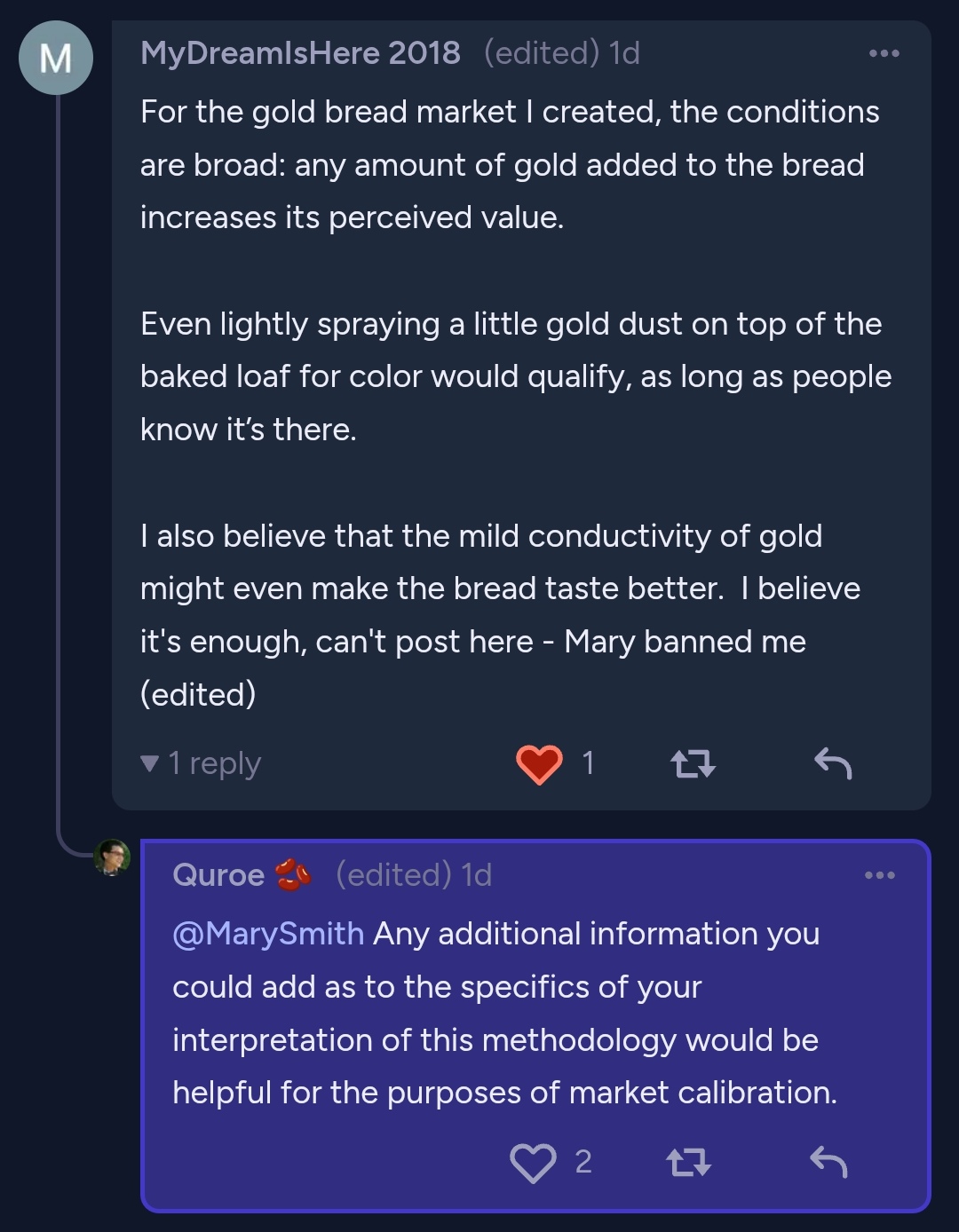
If the change is distinguishable AND is worse, resolves NO
If the change is distinguishable AND is better, resolves YES
If the change is not distinguishable AND does not greatly (25%?ish) reduce time or inputs, resolves NO
If the change is not distinguishable AND does greatly (25%?ish) reduce time or inputs, resolves YES
If I determine the change is too difficult (I have my own mill but sifting by hand could be maybe too tedious?, stuff like grow my own wheat), I am liable to resolve that option N/A
If I determine the change departs too far from the categories "bread" or "loaf of bread" (such as suggesting I make a bread bowl with split pea soup😋 or a BLT 😋 or cinnamon rolls 😋), resolves N/A
I will judge all changes on the criteria:
Crust, Crumb, Moisture, Taste
blinding or double blinding as needed, including tests to verify that the changes are distinguishable and not subject to order effects.
I may have others, as available, provide their input on these at a rate of 50% or less of my ratings for a weighted avg.
I will extend the overall market until some period x where noone's interested and I've iterated through the suggestions.
Base Recipe:
800 g All-Purpose Flour, Unbleached (King Arthur)
600 g Water, RO filtered (Waterdrop G2P600)
17 g Salt, Coarse (Morton Kosher)
4 g Yeast (Fleichmann's/ REDSTAR)
Heat water to 30±1 °C
Add 17±0.5 g salt and 4±0.3 g yeast to jug
Mix in 600±5 g water to yeast and salt jug (prevents salt & yeast clumps in dough)
Weigh out 800±5 g flour in big bowl
Mix jug into bowl until no dry flour
Wait 14±2 hrs, bowl covered on dinner table
Preheat oven to 465±15 °F with Lodge cast iron dutch ovens inside
Split dough and shape into rounds
Place rounds on parchment paper and cut design
Open dutch ovens and place loaves
Spritz 30±2 g water around each loaf
Bake 30±3 min, closing and placing dutch ovens in oven
Spritz 30±2 g water around each loaf
Bake 15±3 min, placing dutch ovens in oven without lid
Place loaves on cooling rack
I never really disliked AI until this bot. It's worse than bad autocorrect. Ignore anything the bot says ever.
THERE WILL BE NO AI CLARIFICATIONS ADDED TO THIS MARKET'S DESCRIPTION.
Start at 500F, drop to 450F and uncover half way through
Was kind of a pain because I couldn't bake any other iteration. I was hopeful it would lead to better spring/ better browning but it did not!
NO
Bake vodka into it
Flattened out the loaf, taste testers though it was reduced salt.
NO
Half yeast
Tasters could distinguish between the two blinded but oddly enough didn't prefer 1/2 yeast when unblinded, but didn't mind when they were blinded. As it decreased the yeast by 50% and at least in this loaf, didn't clearly harm the crust, crumb, rise, moisture, flavor, etc., it's a YES
YES
Add a pinch of sugar
After testing the other sugar market I figured this one would be a dud.
NO
make the bread bounce
CANCEL
@MarySmith @Odoacre Resolved Odoacre's "Watch the video & Ditch current process, do everything the same as the video options" 50% as they had a similar issue to the good single day loaf. I don't prefer the bread, but it's good bread. Some of the taste testers preferred it to control, others didn't. It's got a lovely texture and a good crumb, and an ok crust (the video's crust looked waaaaaaay better than the outcome over here and I extended baking a little bit to get the outcome to look closer to the outcome in the video). I have not been (and for the most part, neither have the taste-testers) impressed with the options that add sugar into the loaf, but this sure did impress enough that they have prodded me into resolving it 50% in line with the other market I did that for "Bread flour, 3x yeast, cut rise to ~3h"
@traders In the next 72 hrs, I plan on resolving start @ 500 and drop to 450, vodka, pinch of sugar, half yeast, and watch vid/do vid instead.
@nikthink doing them all in one loaf would make no sense for assessing the Δ between any specific change and control. So no, I don't combine all of the proposed changes I'm testing, that would be preposterous.
@nikthink @Quroe linked https://www.youtube.com/watch?v=5oULEuOoRd0 one
day and I'm not opposed to doing a multi variate test when and where it would make sense.
@MarySmith It sounds like you can't view my comment due to it being a reply under a blocked user's comment. This was my clarifying question.

@Quroe based off the option creator's comment, I would shave off a fleck of gold from something or find some other, cheap way to include >0 g gold in the bread, and most crucially, tell each taste tester "this bread has gold in it" which I think is what will really do the heavy lifting.
If the testers express a preference for the bread with gold in it, I will add a distinguishing test where I give them 5 random samples from control and treatment to see if they can distinguish between the two better than random chance.
@MarySmith I am open to modifying this to be more in line with the option creator's expectations given they made the option, as long as it doesn't conflict with the other expectations outlined in the market description, manifold tos, my moral code, etc.
@MarySmith I am open to the argument, if the originator puts it forth, that this should only be tested including the merits of the psychological effect of the knowing there is gold in the bread. In such a case, I would not bother with testing to see if the tasters can differentiate the two. One still could by randomizing both treatments e.g. randomizing telling the tasters there is gold and randomizing whether they are given the piece with gold to eat. I'm not sure if I'm comfortable testing both at the same time, I'd have to look into it.
@MarySmith Note that, if you've blocked them, they cannot even comment on this market. Would you like me to make an unlisted post page for them to reply on? I feel like I would have an undue amount of power by being their counterparty and their filter, but I could relay their responses to you if they seem like they're in good faith.
For the gold bread market I created, the conditions are broad: any amount of gold added to the bread increases its perceived value.
Even lightly spraying a little gold dust on top of the baked loaf for color would qualify, as long as people know it’s there.
I also believe that the mild conductivity of gold might even make the bread taste better. I believe it's enough, can't post here - Mary banned me (edited)
If people prefer bread with even a small amount of gold over bread without, the answer to the question becomes a clear YES.
@MarySmith Any additional information you could add as to the specifics of your interpretation of this methodology would be helpful for the purposes of market calibration.
@MyDreamIsHere2018 I've created a space for you to discuss the "piece of gold" market answer, since I don't think you can comment here anymore.
I N/A'd a bunch more either because they were duplicates, trolling/meaningless, not coherent enough, just enrichment, not something I was going to even attempt to resolve, etc afaict. I'd rather traders have their capital sooner than later. I've also now resorted blocking MANY suspiciously new accounts making/betting on these as I figure the nonsense markets could be used to farm bonuses... (knowing they will be N/A'd)
Sell your bread at an auction and donate the money to those in immigration detention prisons.
CANCEL
Cut into the dough right before baking looks destructive to improve the appearance
CANCEL
Do it with a good spirit in your heart, or ask someone with a good spirit to do it for you. But don’t watch while they do it.
CANCEL
Short advice: Start baking at 260°C for strong rise, then reduce to 230°C and uncover halfway to achieve even browning and a crisp crust. 🍞
CANCEL
If your city uses artesian water, replace plastic bottled water with tap water. It will add natural, healthy alkalinity to your bread.
CANCEL
Tarriff the bread-making process with a 10% reduction of all ingredients where actual physical money is required to purchase them, until it “shrinkflates,” but try to keep the same volume. Do not reduce any free ingredients.
CANCEL
Use a food-grade, human-approved vitamin D supplement in the correct dosage for testers with vitamin D deficiency
CANCEL
Don’t use usual water (room temperature) for the dough - that water’s only for toilets. Use electrolyte drinks instead with ice cubes; they make the dough taste better and add extra nutrition.
CANCEL
Get your friends to help you make a batch ten times the size, but add a Pepper X (2.7M Scoville heat units) to the mixture
CANCEL
Ask yourself if bread is healthier than fruits? No need to improve my bread
CANCEL
Ship a piece of the bread to a random person.
CANCEL
Instead of RO water, use lightly rusty water to improve the nutritional value of the bread with soluble iron.
CANCEL
@hruss Okay, yes, sure. Haha! But what kind of bread would I be betting on here? Am I betting on bread with coffee grounds infused in the dough? Or are we using coffee instead of water? Or something else currently beyond my imagination?
@Quroe i think the optimal would be something like pure (?) caffeine added to the bread in an amount that is enough for the testers to notice the difference clearly. However, something like replacing some or all of the water with cool, brewed coffee, or adding instant coffee could also work. Ultimately, the point is the caffeine, not the coffee flavor.

